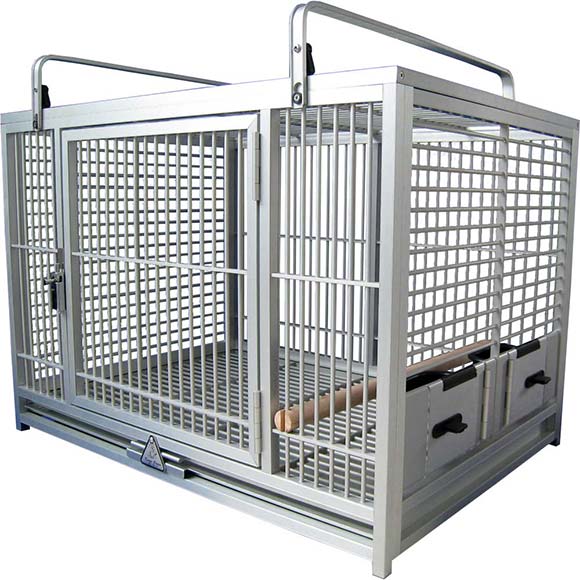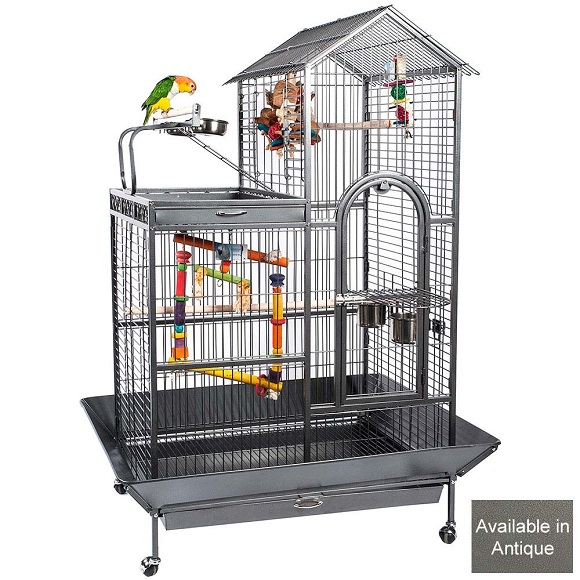Your Guide to Easy Cage Selling
Published on Tuesday, 29th August 2017
A cage is arguably the second biggest investment (after the bird) for any Parrot owner.
Helping your customers make the right choice isn’t difficult. It can have an initial impact on your profits as well as long term, as they keep coming back for more advice, food, toys and accessories.
Here’s a useful guide to the cage features you and your customers need to consider…
1. Bar Thickness. Some Parrots have very powerful beaks, and they can break welds, bend or break the bars – Cockatoos and Macaws for example. It is important that the cage bars are strong enough to withstand their strength.
Small: Canaries, Budgies: 2mm.
Medium: Lovebirds, Conures: 2.5mm.
Large: Quakers, African Greys, Amazons, smaller Cockatoos: 3.5mm.
Extra Large: Larger Cockatoos, Macaws: 5mm or more.
2. Bar Spacing. This is the gap between the bars. If the spacing is too wide birds can get stuck or even escape. If too narrow the bars are unlikely to be strong enough, plus it impedes the view for the Parrot looking out and your customer looking in.
Small: Budgies, Cockatiels: 1cm (0.5”).
Medium: African Greys, Amazons, Conures: 2cm (0.75”).
Large: Larger Cockatoos and Macaws: 2.5cm (1”)
3.Internal Space. The space inside a cage quickly gets taken up by toys and accessories. Some Parrots like Caiques, are highly active and need plenty of room to fly and exercise. Ideally Parrots need a horizontal space that is 2-3 times their wingspan in width and depth.

If the Parrot has a crest (Cockatiels and Cockatoos) or a long tail (some Parakeets, Conures and Macaws) they will need a cage that is tall and wide enough to prevent their feathers from touching the roof, floor and the cage sides. Here’s some examples of the minimum internal dimensions we recommend (Width x Depth x Height)
Budgies, Canaries, Cockatiels: 45cm (18”) x 35cm (14”) x 51cm (20”)
Caiques, Senegals. Conures: 48cm (19”) x 48cm (19”) x 58cm (23”)
Amazons, African Greys, smaller Cockatoos: 66cm (26”) x 56cm (22”) x 102cm (40”)
Larger Cockatoos, Macaws: 89cm (35”) x 66cm (26”) x 119cm (47”)
It is always best for your customers to provide the largest cage possible (based on their budget and available space in the home). If space is at a premium and a separate stand or play gym cannot be accommodated, then a Play Top or Open Top cage should be considered. Both options (especially the Play Top) provide a dedicated space for your customer’s Parrot to play and exercise outside of their cage.
4.Feeding Dishes. For smaller Parrots including Budgies and Cockatiels, plastic feeding bowls should be strong enough. However, larger Parrots can easily chew these so we’d recommend a cage with stainless steel bowls. Ideally ones that fit on to swing-out feeder doors, these allow your customers to access their bird’s food and water without entering the cage, which is less stressful for the birds.
5. Doors. Drop down landing platforms provide a level and a secure place for birds to land on, rather than trying to grab hold of the cage bars. Large front doors make access for cleaning and maintenance easy, and for getting a bird in and out.
6.Security (Locks). Parrots are intelligent and there’s been many stories of them opening the lock and flying out. A cage with a multi stage lock significantly increases security and reduces the risk of escape.
7.Metal Type and Coatings. Certain metals are poisonous if ingested (Lead and Zinc). Most Parrot cages nowadays are made from steel and finished with a tough non-toxic powder paint coating. Stainless steel and toughened aluminium cages may be more expensive but they don’t have a painted surface which can chip and flake off over time.
8. Movability. Castors or wheels at the bottom of the cage make moving Parrot cages a lot simpler, especially during cleaning and maintenance of the larger and heavier cages.

9.Seed Catchers (Skirts). Most Parrot cages come with removable panels that fit around the bottom of the cage and slope in. They help catch any mess and divert it to the bottom of the cage. Helping to keep your customer’s home clean.
10.Slide-out Grilles and Trays. To make cleaning the cage easy, many cages come with slide-out grilles and trays. Grilles allow waste and mess through to the tray below and helps prevent the Parrot from reaching it. Trays collect all the mess and can easily be removed for cleaning without entering the cage.

